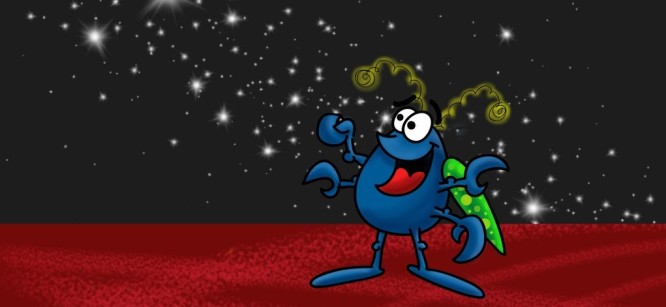Simple, they look up to the sky, because the answer is written in the stars
You may recall from a previous post that us dung beetles use the sun’s polarization to guide us in a straight line back home. Like many other insects, we have photoreceptors that enable us to see the polarisation. Well, at night we use the moon’s polarisation, rather than the sun.
But what happens when the moon is hiding?
As you would expect, the dung beetle just gets on with it. A research team noticed that hard working night shift dung beetles were still busy rolling (in straight lines home, not wandering around aimlessly) even when the moon was no where to be seen.
So, in a cunning plan, the scientists devised yet another experiment for us dung beetles to tackle (and as usual, we did not disappoint)
This experiment involved placing an unsuspecting dung beetle and its prized dung ball in a large inverted circular drum. This stopped the beetles from seeing anything land based.
One by one, they placed beetle after beetle into the drum and observed the following:
- with the full moon shining, it took about 20 seconds to reach the edge
- with a starry night and obscured moon, it took about 40 seconds
- and with no moon or stars (they had to place a hat on the poor dung beetle!), it took a whopping 2 minutes
So, now we know why you never see a dung beetle wearing a hat while working (it just makes work 6 times harder)
But what else did the scientists figure out? The experiment demonstrated that the moon’s polarisation offered one form of navigation, but that the ‘line’ of the Milky Way stars offered an alternate navigation source, when the moon was nowhere to be seen. Although dung beetles have ‘simple’ eyes and cannot see individual stars, they can see the sparkling line of the beautiful stars within the Milky Way.
References: To my surprise two research teams have undertaken similar research studies into dung beetle night rolling. This article by New Scientist and The New Yorker were particularly well written. Would rather watch than read? Check out this DNews report – not surprisingly, it comes with some ‘poo’ jokes.


I continue to be amazed by the dung beetle. Thanks for this post!
LikeLike
Pleasure, hopefully more to come…very hard to find information on dung beetles. They’re a big beetle in a small dung ball – can’t find much on internet about them… If you have any ideas? 🙂
LikeLike
The story of how and why the dung beetle arrived in Australia is interesting, especially when you consider that many attempts to introduce foreign species in various parts of the world have been failures.
LikeLike
Fascinating! My little fellas out in the paddock are very busy at the moment – cow poo and rain =lots of work!
LikeLike
Ooh, exciting. Do you have rollers like Doug, or tunnellers. The majority of Australian dung beetles (well, those imported for cow dung purposes) are tunnellers. A pity in a way, as I find the rolling very entertaining
LikeLike